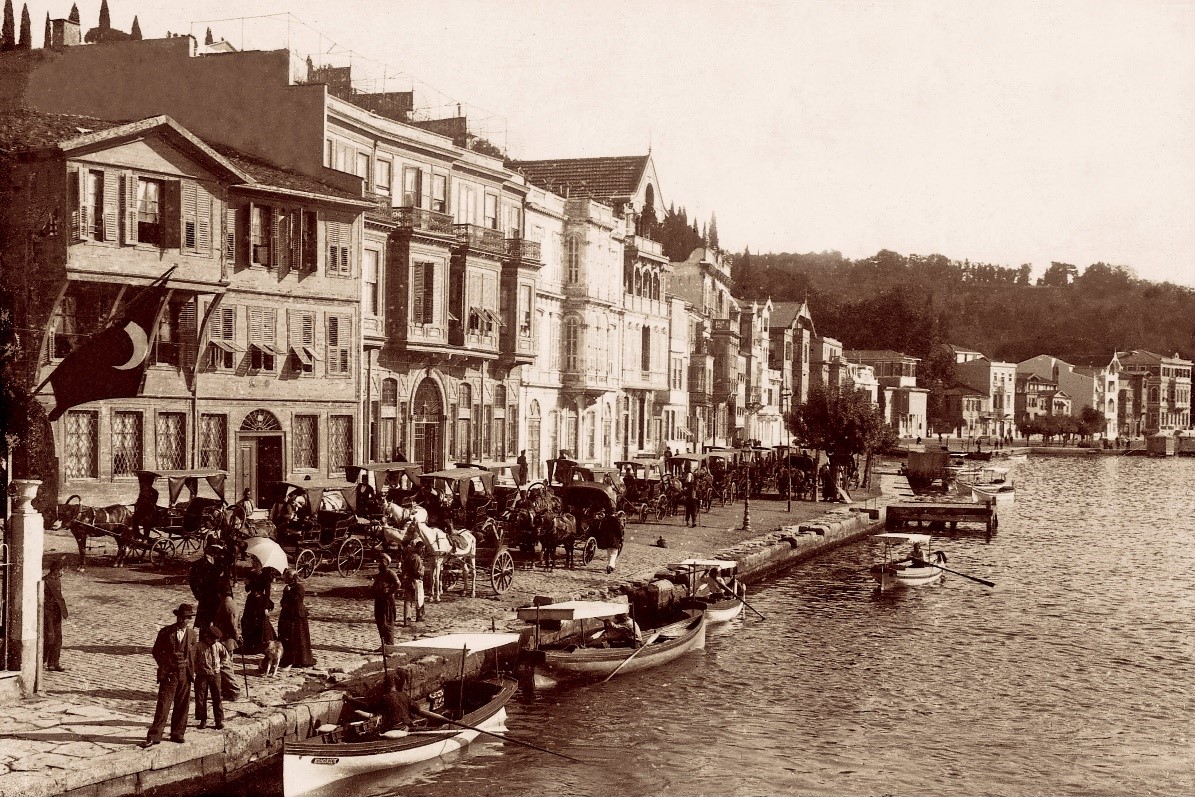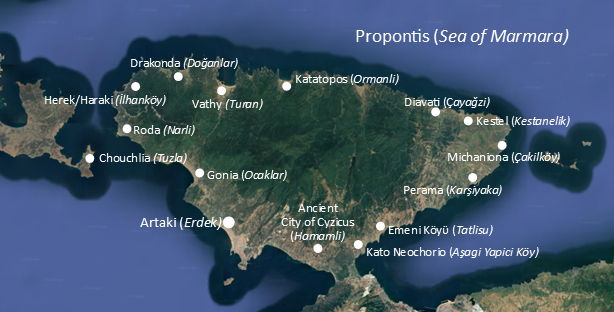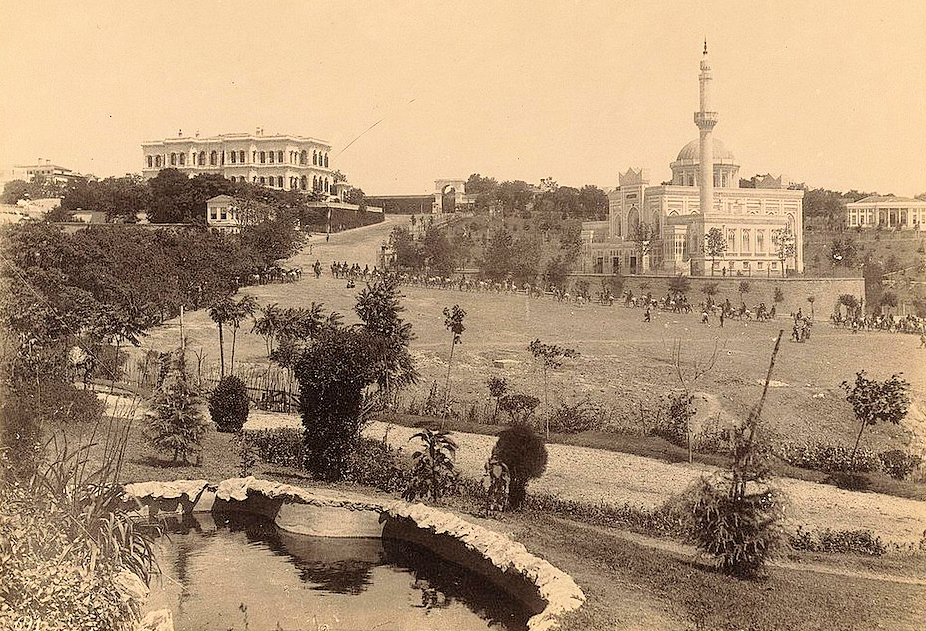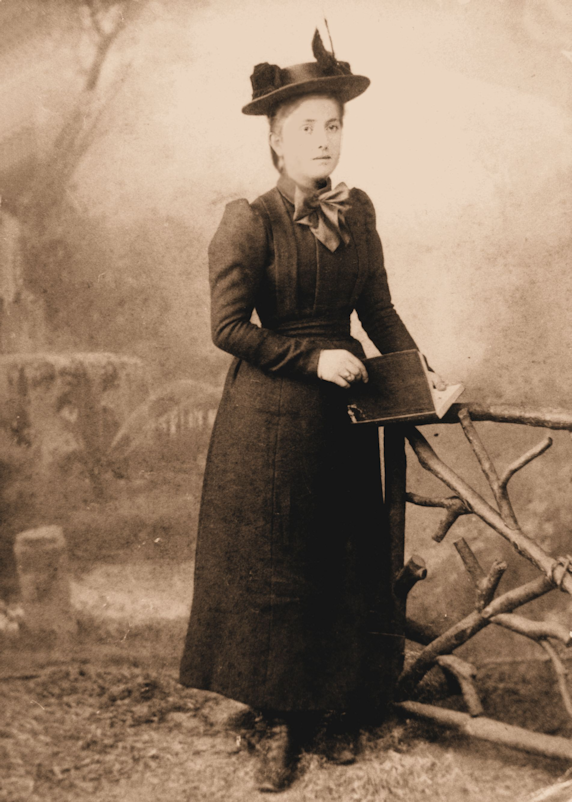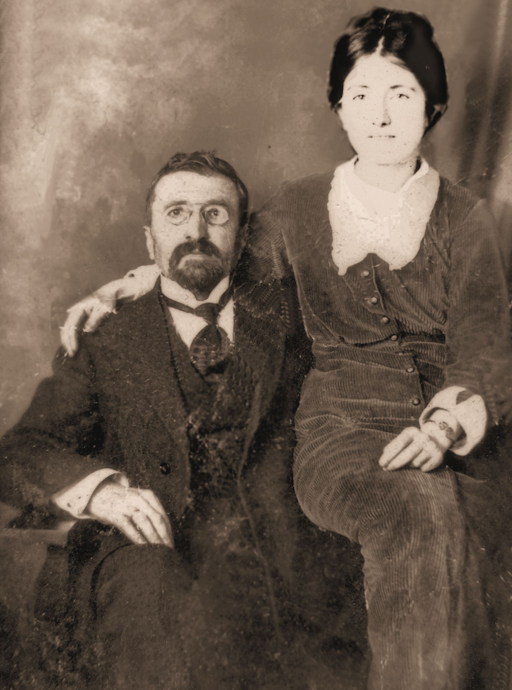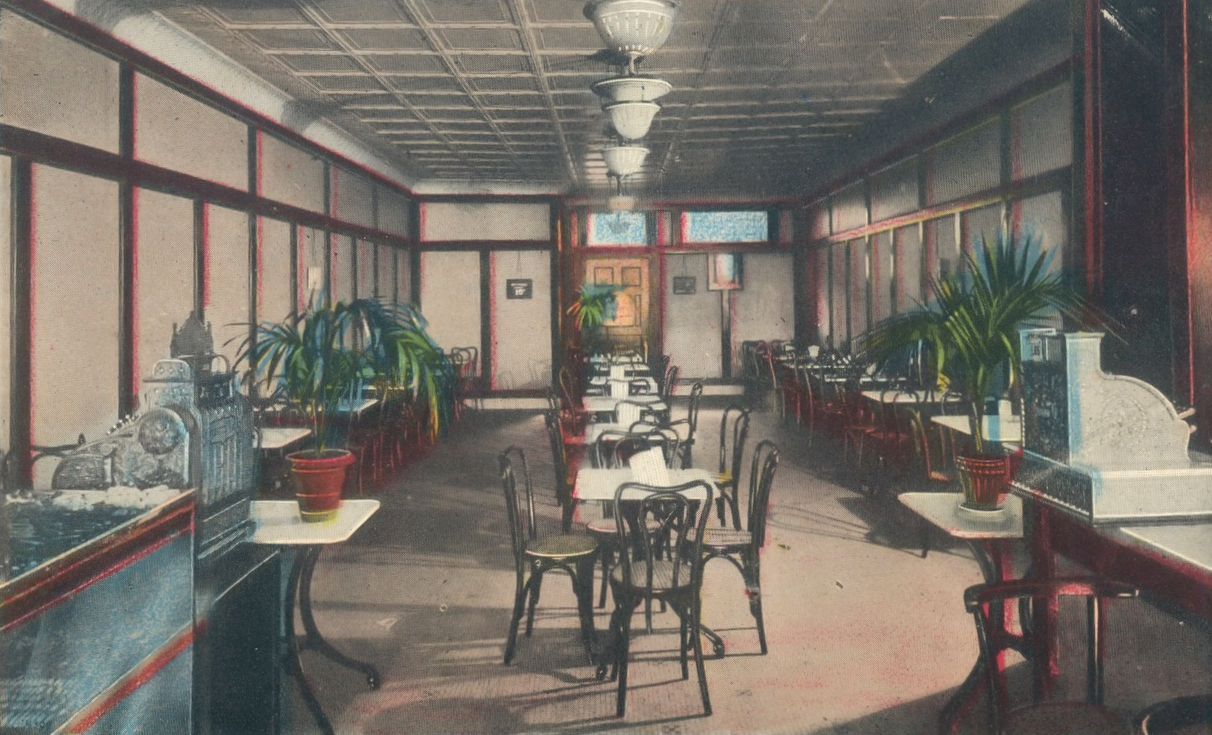Helene Kelessidisof Constantinople, Asia Minor and New London, Connecticut |
|||||||||
 |
|||||||||
|
Helene Kelessidis was born 4 February 1886 in Büyükdere, a quarter of the Sariyer district in Istanbul (then Constantinople) Province, Turkey on the banks of the Strait of Bosphorus where Greek and Armenian minorities lived. Helene was one of two daughters born to Georges and Caroline (Kaliroi) Kelessidis. In the 19th century, Büyükdere was known for its scenic beauty. In 1838, Lamartine wrote, "Büyükdere, a beautiful town at the extremity of the gulf formed by the Bosphorus where it turns to lose itself in the Black Sea extends like a curtain of palaces and villas along the sides of two sombre mountains. A fine quay separates the gardens and the houses from the sea." "…the beautiful plane of Büyükdere on the left with its group of wonderful plane trees, one of which would shade a whole regiment; the magnificent force of the palaces of the Russian and Austrian embassies which fringed the brows of the hills; the elegant balconied houses which border the quays with festoons of flowers overhanging their terraces…" (Lamartine, 1838) |
|||||||||
|
|
|||||||||
|
Büyükdere Waterfront, early 1900s, along the Strait of Bosphorus. Photo: Wikimedia Commons |
|||||||||
.jpg) |
|||||||||
|
Map showing location of Büyükdere in relation to Constantinople. Map: S.R.Cox |
|||||||||
 |
|||||||||
|
ORIGINS OF HELENE'S FAMILY |
|||||||||
|
The early origins of the Kelessidis family are most likely found in the Pontus Region of the Black Sea coast. Greek etymology places surnames ending with “idis” in this region [1]. The birthplaces of Helene’s Kelessidis relatives on ship’s manifests also verify this. These family members came from Trapazounda (Trabzon on the southern Black Sea Coast of northern Turkey), Sozopolis, Russia (probably Sozopol, Bulgaria on the western Black Sea coast) and Baktesari, Russia (probably Bakhchysarai, Ukraine on the Crimean Peninsula which juts into the Black Sea from the north)[2]. |
|||||||||
|
|
|||||||||
|
Map showing the locations in the Black Sea region where members of the Kelessidis family lived. Map: S.R. Cox |
|||||||||
|
T |
|||||||||
|
|
|||||||||
|
Map of the Cyzicus (now Kapıdağ) Peninsula with location of Michaniona. Map names: The Encyclopaedia of the Hellenic World |
|||||||||
 |
|||||||||
|
HELENE'S UPBRINGING |
|||||||||
|
In 19th and early 20th century Turkey, the Ottoman court employed many members of ethnic minorities, including Orthodox Greeks (Byington et al., 2022). Georges Kelessidis was a lead chef to the Sultan of Turkey, Abdülhamid II (Patterson Family Oral History). According to the family, the Kelessidis family lived, at least during part of their residence in Constantinople, at the Sultan’s palace, probably Yildez Palace. Sultan Abdülhamid II moved to Yildez Palace in 1877 for security purposes [5]. The Yildiz Palace, meaning "Star Palace" was a huge administrative center - a complex of buildings over a large area of hills and valleys that housed approximately 12,000 people during Abdülhamid II's reign [6]. Although verification has not been found of the Kelessidis family living there, if George Kelessidis was in the employ of the Sultan during this time, Yildiz Palace is probably where he would have lived. |
|||||||||
|
|
|||||||||
|
Yildiz Palace, grounds and mosque. Photo: Wikimedia Commons. |
|||||||||
|
According to the family, about 1891, when Helene was five years old, Georges Kelessidis was loaned by the Turkish Sultanate to the Vatican. The Kelessidis family spent five years inside the Vatican, until around 1896. Here, Helene developed greater fluency in Italian before she did Greek. (Patterson Family Oral History). Relations between the Ottoman state under Sultan Abdulhammit II and the Vatican under Pope Leon XIII improved over previous leadership of the two countries (Türkan, 2015). Verification of George Kelessidis' assignment to the Vatican has not been found, however on 30 March 1898 the Ottoman State decided to establish diplomatic relations with the Vatican for the first time. An Imperial decree determined that Asim Bey, formerly the ambassador to Athens, would be appointed as the Ottoman state's first ambassador to the Holy See "because other states have sent ambassadors to the Papacy and the request from His Holiness the Pope that His Imperial Majesty should follow suit." (Deringil, 1993) Although this event took place shortly after the Kelessidis family's time at the Vatican, it denotes the positive relations at the time between the Ottoman State and the Holy See. According to the family, young Helene became very attached to the Pope's Great Dane, Pandur (Patterson Family Oral History). In Constantinople, Helene and Hariklia attended the Zappeion School for Girls, a prestigious school for girls named after its main benefactor, Evangelos Zappas. They grew up speaking several languages fluently, including Greek, Turkish, Russian, English, French, Italian, German and Arabic (Patterson Family Oral History). |
|||||||||
|
|||||||||
 |
|||||||||
|
Helene, probably taken 1902-1903 |
|||||||||
|
According to the family, the Kelessidis' went to Cairo during the summer months, where Georges Kelessidis cooked for the Khedive of Egypt, Abbās Ḥilmī II. This was Helene's favorite place. The family also spent a few weeks each year in Zurich, Switzerland and would visit Vienna when Austria's great balls took place (Patterson Family Oral History). |
|||||||||
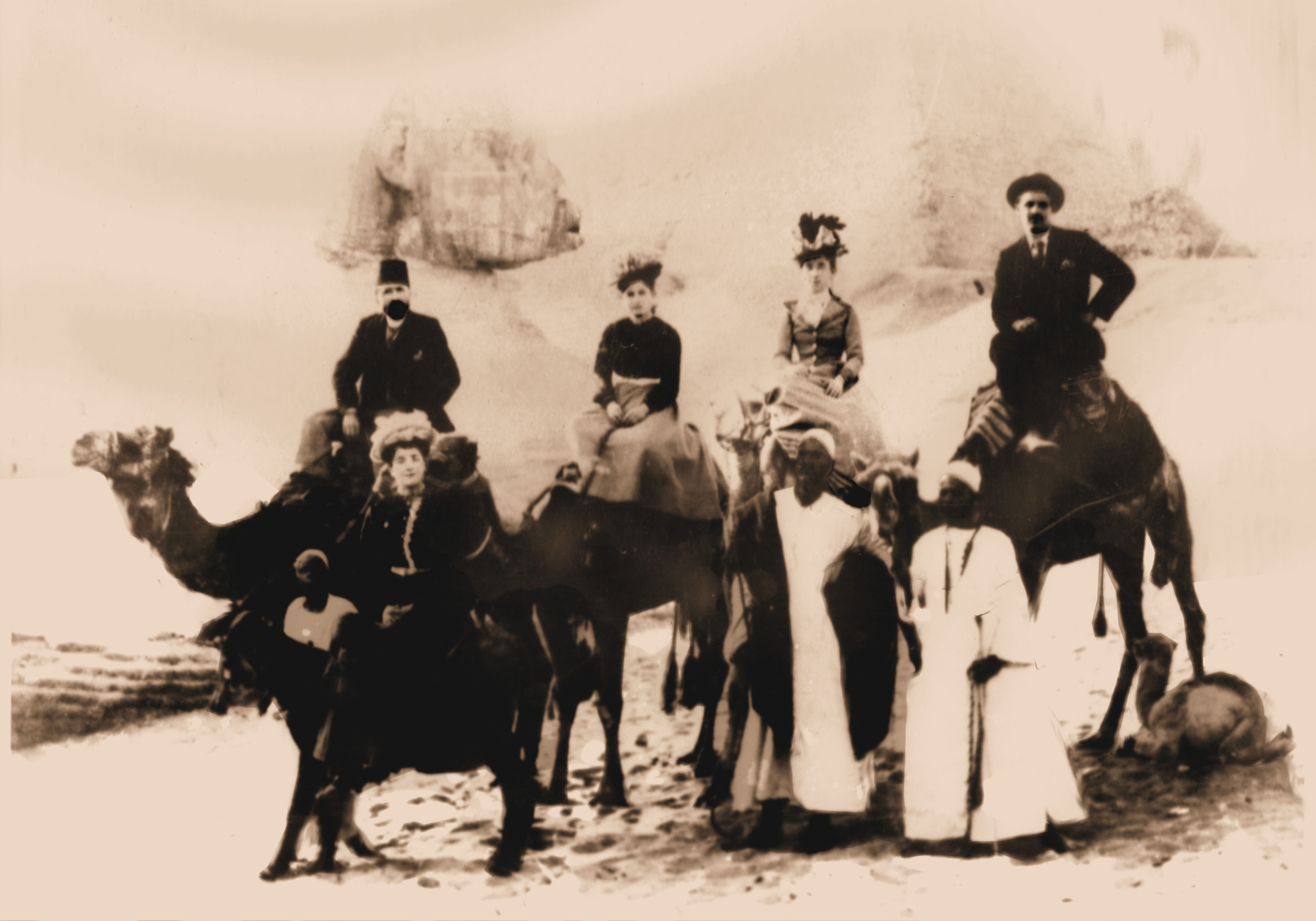 |
|||||||||
|
The Kelessidis family in Giza, Egypt during the summer of 1903 |
|||||||||
|
Front row, left to right: unknown man, unknown woman (probably a relative, but not Helene's sister Hariklia), unknown man, unknown man |
|||||||||
|
Back row, left to right: George Kelessidis, Helene Kelessidis, Caroline (Kaliroi) Kelessidis, unknown man |
|||||||||
 |
|||||||||
|
MARRIAGE TO JOHN SOCRATES PAPANAGNOSTI |
|||||||||
|
In 1903, at 17 years of age, Helene wed, in an arranged marriage, John Socrates Papanagnosti from the village of Vathy, a coastal town on the north-west coast of the Cyzicus Peninsula. John Socrates Papanagnosti, who went by the name Socrates Patterson in the U.S. and later thusly legally changed his name, was 11 years Helene’s senior and had immigrated to the United States in 1893. In 10 years, he established a successful confectionary business in New London, Connecticut. The wedding took place during the summer of 1903[7], probably in Cairo, and Socrates and Helene arrived in the U.S. later that year. |
|||||||||
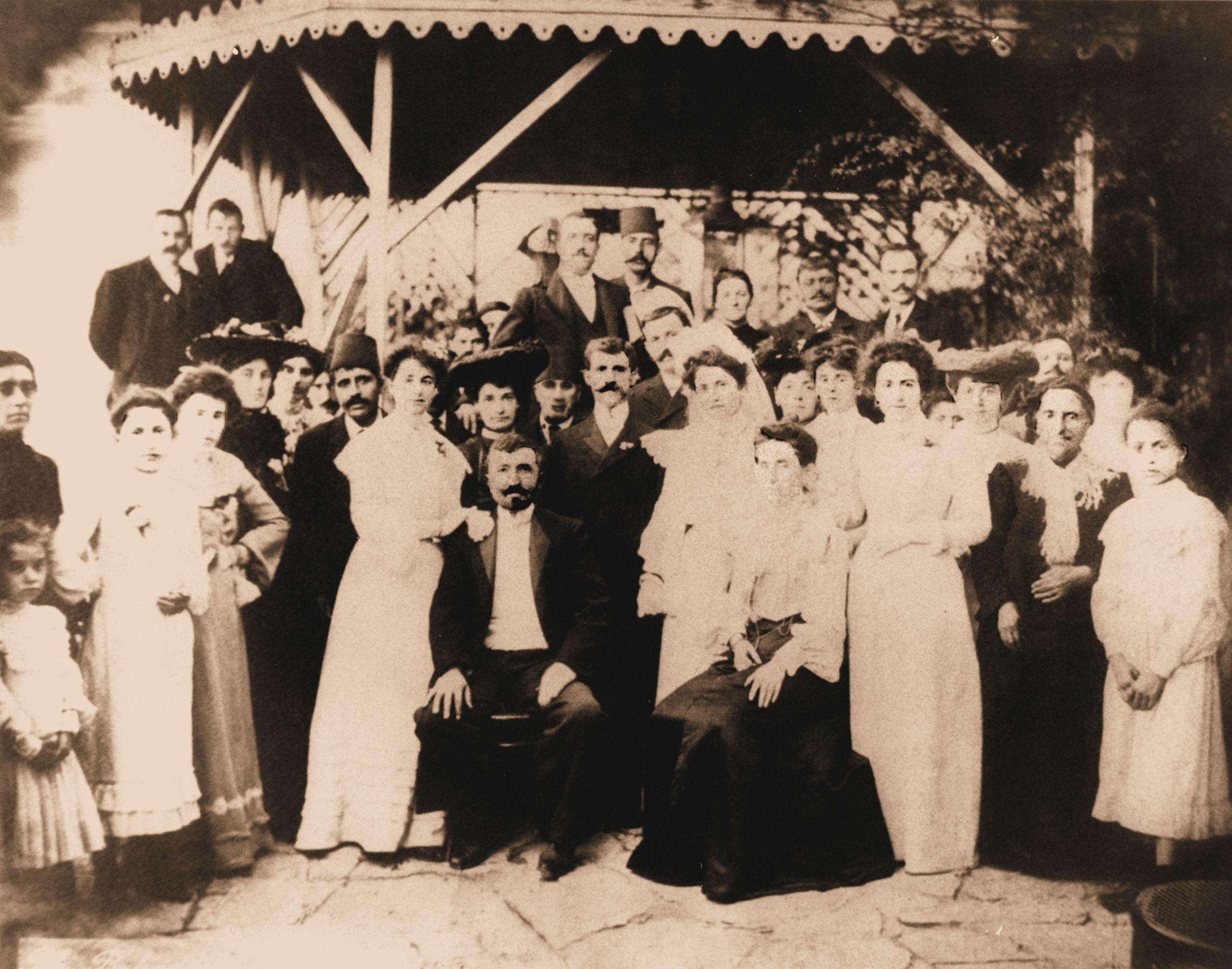 |
|||||||||
|
The Wedding of Socrates Papanagnosti and Helene Kelessidis,
Summer 1903 |
|||||||||
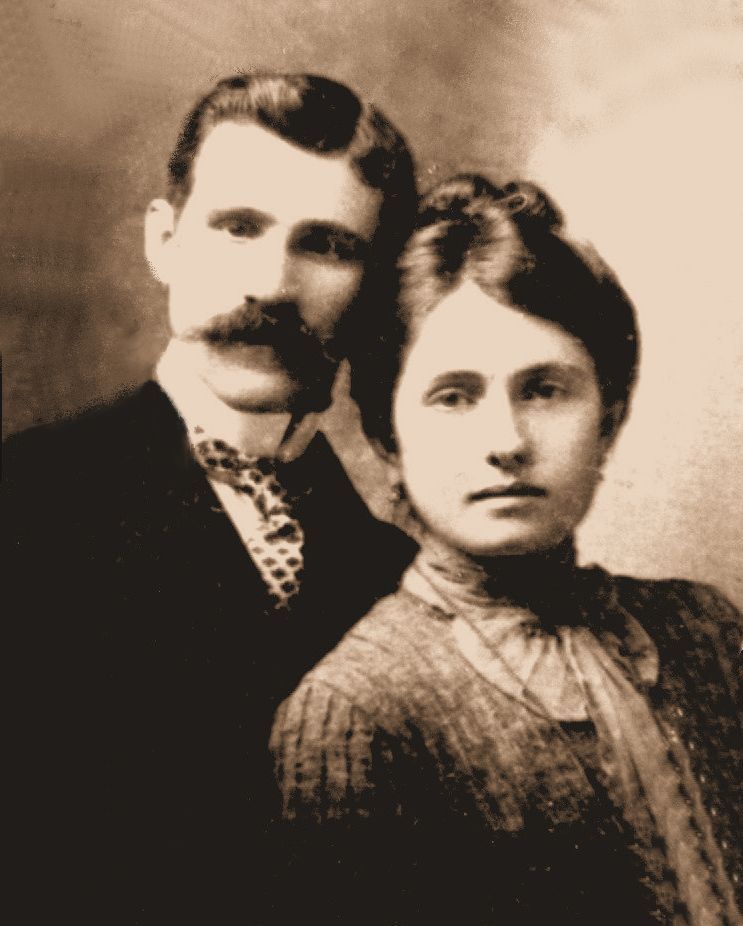 |
|||||||||
|
Socrates and Helene Patterson shortly after their wedding |
|||||||||
|
In view of Helene's young age, traveling to a foreign country with a vastly different culture in the company of a man she barely knew must have been an unsettling experience for her. However, during the first 15 years of her marriage, Helene spent little time on her own without her parents, her mother in particular. She either travelled abroad to spend extended time with her family, or her mother travelled to New London for extended visits, some lasting close to a year. Considering the expense of international travel by ship in the early 1900s, the Kelessidis family must have been financially well off. Shortly after their arrival in New London, Socrates moved his confectionary business to 86 State Street, which he named the Crystal Candy Kitchen. He and Helene were living in a residence at 23 Howard Street[8, 9]. On May 11,1904, Georges and Caroline (Kaliroi) Kelessidis arrived in New York [10], on their way to New London to stay with Socrates and Helene. Now age 18, Helene was expecting her first child and her parents were no doubt there to support her. Two months later, Socrates and Helen's first child, Dionysius, was born on July 11, 1904. An article in New London's newspaper, The Day [11], announced the christening of Dionysius according to Greek Orthodox rite on July 20, 1904. The ceremony was performed by the Reverend Zissimos G. Typaldos, rector of the Greek Orthodox Church in New York who travelled to New London to perform the christening. The godfather was Denis C. Bossos of New York, who christened Dionysius "Denis". At some point in later 1904 or early 1905, Socrates travelled to Europe or Asia Minor, because he is listed on the manifest of the S.S. St. Louis on April 16, 1905, New York from Cherbourg, France [12]. According to the family, some of the trips Socrates made to Europe and Asia Minor included stopovers in Paris, where Socrates sought treatment for a hereditary condition, Bright's Disease, a catch-all term for what is known today as chronic or acute nephritis. A diagnosis of Bright's Disease in the early 20th century was grim; the condition was considered fatal. In 1912, it was the fourth-leading cause of death in the United States.[13] On May 13, 1905, Helene applied for a passport for herself and 10-month-old Dionysius[14]. She listed her place of birth as Büyükdere, Turkey and her date of birth as "on or about the .....day of July 1884", claiming she was 21 years old, although her actual birthdate was February 4, 1886 and she was only 19 years old. She was eight months pregnant with her second child. On June 19, 1905, Helene gave birth to her second child, Xenophon, in Cairo where she had been visiting with her parents. It appears that Socrates was not with her, because on September 15, 1905, he applied for another passport to travel abroad, this time intending to return to the U.S. “within one year”[15]. He no doubt was travelling to bring his young family home. Apparently the family remained abroad through 1906, because on May 5, 1906, Socrates, Helene, Denis - one year, 8 months old, and Xenophon - 9 months old, departed Cherbourg, France, arriving at New York Harbor on May 13, 1906. Socrates’ younger sister, Sotera, accompanied them [16] . This was Sotera's first trip to the U.S. and she lived with Socrates and Helene for the next four years. Upon their return to the U.S., the young family lived at 13 Golden Street. Seven months after their return, Socrates and Helen's third child, Constantine Socrates, was born on 3 November 3 1906 [17]. By 1907, the family had moved to a house at 193 Montauk Avenue. In the summer of 1907, Caroline and Hariklia Kelessidis (Helene’s mother and younger sister) arrived from Turkey for an extended visit. They were accompanied Emmanuel Nicolaou, who identified himself on the ship's manifest as a cousin of Helene's father George Kelessidis [18]. Later that summer, Socrates' older brother, Leonidas Papanagnosti arrived from Turkey [19]. Over the next several years, business at the Crystal Candy Kitchen flourished. Socrates began investing in other ventures as well. In April 1907, he filed a certificate of incorporation with John A. Scott, Edward S. Doton, Walter S. Calvert, and Leolin A. Comstock for The People's Coal Company of New London.[20] The authorized capital stock was $20,000 ($582,057 today) and business began at $2,000 ($58,206 today). Socrates continued to run the confectionary business at the 86 State Street address, but by 1908, he had joined in partnership with his nephew, Stavros Peterson [21] for the Patterson & Peterson confectionary at a new store at 127 State Street. On April 23, 1908, Socrates and Helene's fourth child, George, was born, named for Helene's father George Kelessidis. Helene was 22 years old, the mother of four children, all boys, under the age of five. A November 1908 article in The Day reported that Socrates and family had moved from 193 Montauk Avenue to 10 Pearl Street. |
|||||||||
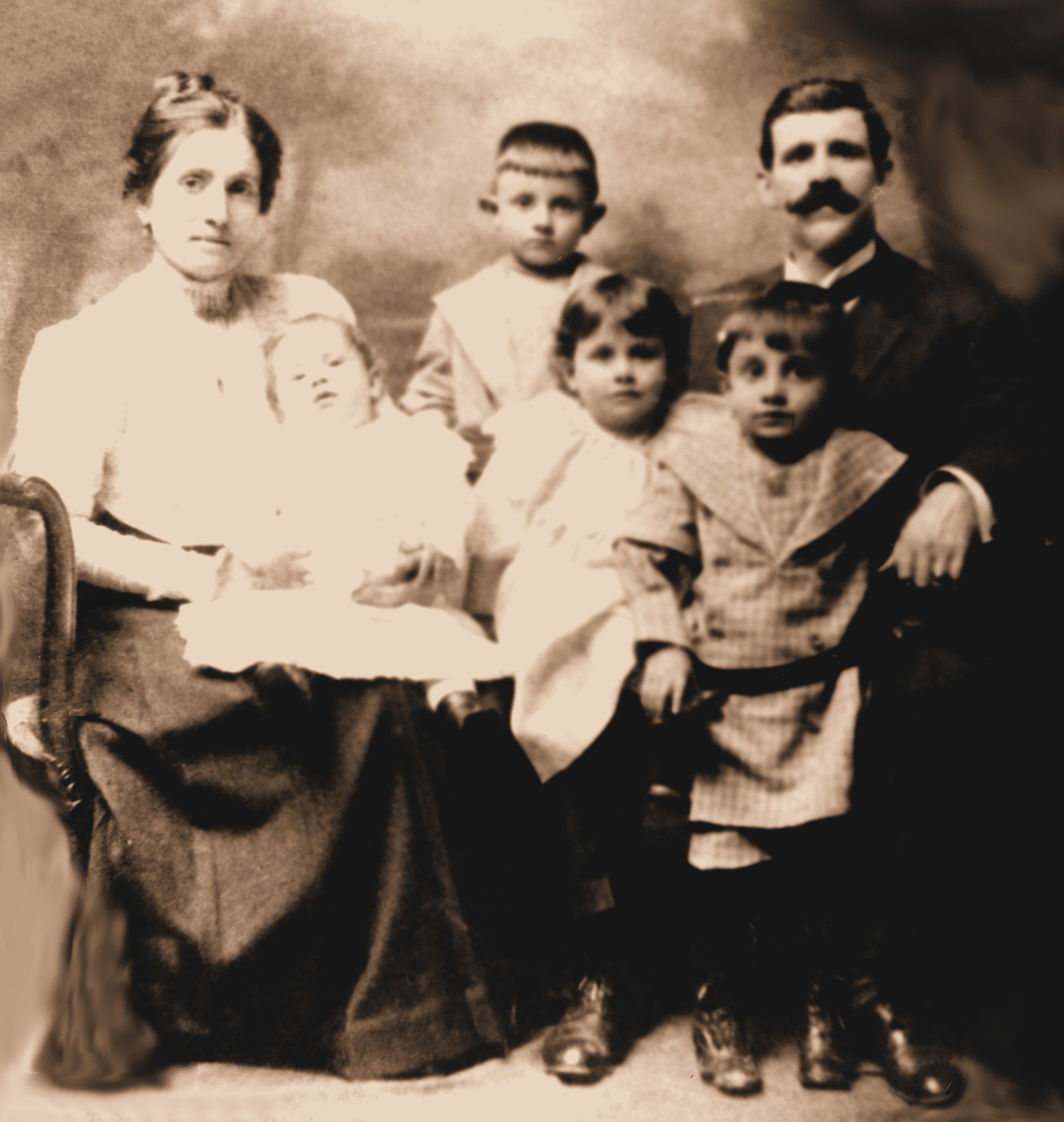
Late 1908 or early 1909: Helene, Socrates and their four oldest
children: |
|||||||||
|
|
|||||||||
|
On 21 September 1909, Caroline (Kaliroi) Kelessidis arrived in New York enroute to New London, no doubt to help Helene and Socrates with the arrival of their fifth child. A little over two weeks later, on 9 October 1909, Pontelius (Ponte) Patterson was born. Socrates' sister Sotera married George Cozakos in New London on 23 February 1910. The family of George Cozakos came from Vathy and its neighboring village, Charaki (Haraki or Herek) on the Cyzicus Peninsula. He had arrived in the U.S. in 1903 and settled in Salt Lake City, Utah, where a cohesive and insular Greek Orthodox community developed and co-existed among the Utah Mormons. Like his fellow countrymen in New London, George Cozakos established a successful confectionery business. Shortly after their wedding, George and Sotera returned to Utah, where they remained for the rest of their lives [22]. The 1910 census[23] was taken on 28 April 1910, showing the family living at 193 Montauk Avenue and Caroline (Kaliroi) still in New London. Socrates, age 38, appeared as head of the household with wife Helene, age 24, and five children under the age of seven: sons Dennis, age 6; Xenophon, age 5; Constantine, age 3; George, age 2; and Pendleton [sic](Pontelius), age 6 months. Nephews Peter (Stavros) Peterson, age 23; and James Peterson, age 19 were also listed as members of the household, along with Helene’s mother, Caroline (Kaliroi) Kelessidis, age 48. The nephews were Stavros (Panayotis) Peterson, who also went by Peter or Pete, born 20 March 1887, and his younger brother, James (Demetrio Panayotis) Peterson, born 12 August 1889. Stavros and James were the sons of Socrates Patterson's sister, Smaragdi, and her husband Panayotis Fountoukakis. Socrates brought both boys to the U.S. to help with his confectionary business. Stavros had already been in New London for 9 years, having arrived in the U.S. at the age of 13 in the care of Socrates' business partner, Vasil Vardopoulos, on 30 June 1901 aboard the S.S. La Champagne. James arrived in 1906 at the age of 16 , accompanied by Diamanti Balassi and Andrico Voulgarelis. During this time, Socrates began acquiring new real estate in New London. An April 11, 1910 article in The Day reported that he moved from the Pearl Street address to "his farm on Ocean Avenue".[24] This may have been a tract of land that several years later Socrates began to develop on Bentley Avenue, which intersects with Ocean Avenue and was the main thoroughfare to Ocean Beach Park.[25] On 27 July 27 1911, Helene, claiming citizenship through the naturalization of Socrates, applied for a passport from herself, four-year-old Constantine and three-year-old George, probably to visit her family in Constantinople. A ship manifest confirms the trip they took, returning aboard the Rochambeau from Le Havre on 11 November 1911 [26]. |
|||||||||
|
The Arrival of Helene's Cousin, Constantinos Kelessides (Gus Kelles) |
|||||||||
|
Socrates and Helene's sixth child, Demosthenes, was born on 16 April 1912 [27]. Helene's mother, Caroline (Kaliroi) must have been present for the birth and then brought two-year-old Ponte Patterson home with her to Constantinople and to Piraeus, Greece to visit relatives. On 11 July 1912, she boarded the S.S. Athinai with Ponte at Kalamata, Greece, listing her "cousin", Michael "Celepides" (Kelessidis) of Piraeus as her nearest relative from the country she was departing. Michael Kelessidis was a cousin of Caroline's husband, George. Boarding the same ship was 23-year-old Constantinos Celessidis, listing his father, Michael "Celessidis" (Kelessidis) of Athens as his nearest relative from the country he was departing, and his "cousin" Socrates Patterson as the relative he was joining in the U.S.[28] A 21 August 1912 article in The Day reported that Demosthenes was christened in a ceremony at the family home on Montauk Avenue by the Reverend Thomas Pappageorge of Newark, New Jersey [29]. On 2 September 1913, Michael Kelessides arrived in New York on his way to the Patterson address in New London to see his son, Constantine Kelessidis. He gave his place of birth as Trapazounda, Turkey, and his current address as Athens [30]. The following month, on 20 October 1913, George Kelessidis arrived to visit the family, perhaps timing his visit to see his cousin, Michael [31]. Constantine Kelessidis, who later went by the name, Gus Kelles, must have come to help with Socrates' business, however he didn't appear in New London directories until 4 years later. |
|||||||||
|
|
|||||||||
|
Socrates' Business and Investments Grow and Thrive |
|||||||||
|
As Socrates' business, land holdings and family grew, so too did the population of the Greek community in New London. Most of the Greeks in New London came from Turkey, and many of them developed successful businesses. Socrates and Stavros Peterson were not the only confectioners in town, as several new businesses developed in the early 20th century, including the Boston Candy Kitchen, the Pequot Candy Kitchen, the New London Candy Kitchen, the Capitol Candy Shoppe, and the Colonial Candy Kitchen [32]. Socrates purchased a store at 124 State Street adjoining the Patterson & Peterson store at 127 State Street. He moved the Crystal Candy Kitchen to 76 State Street and now listed it as a confectionary and ice cream business[33]. 1915 saw the completion of renovations to the Crystal Candy Kitchen and Socrates celebrated in a big way. A 9 January 1915 article in the Day noted that throngs of people crowded into the opening of the renovated new store at 76 State Street. The interior was decorated with palms and flowers, music was provided by an orchestra, and souvenir calendars and tickets redeemable for boxes of chocolates were handed out. The new store featured a large soda fountain and spacious ice cream parlor [34] During this time, Socrates bought a rooming house at 45 Tilley Street. In addition to his own large family, between 2014 and 2019 he and Helene rented rooms to several members of the Greek confectionary community, including Trefon George, James Peterson, Tilemahos Svoris, Stavros Peterson, Emmanuel Jackson (Helene's cousin), Frank Prottas, and Gus Kelles[35]. Soon thereafter, Socrates sold to his nephew, Stavros Peterson, his share of the interest in the Patterson & Peterson Candy Kitchen at 127 State Street. A March 15, 1915 article in The Day[ 36] clarified that Socrates had sold his interest in the joint venture with his nephew, however he had not sold The Crystal Candy Kitchen at 76 State Street and would continue to do business at this store while Stavros would continue to operate the former Patterson & Peterson's store as Peterson's Candy Kitchen. Running a candy store could have its hazards. On December 15, 1915, The Day [37] reported that Socrates lost a $300 diamond (more than $7,000 today) from the ring he was wearing in a batch of molasses peppermint candy he was preparing. He offered a reward for the return of the diamond, which he believed was included in the candy someone purchased. An 8 December 1916 article in The Day[39] reported that Socrates legally changed his name from “John Socrates Papanagnosti” to “Socrates Patterson”, with equivalent name changes for his family. At this point, Socrates' life in America was a success by all accounts. He had fulfilled the American dream. He built up a prosperous business from practically nothing, having arrived in this country at barely 21 years of age and with two bags of possessions to his name; he was a father of a thriving brood of children. He was a respected resident of New London and a pillar of New London's Greek community. He continued to acquire property in New London. Despite this success, he continued to struggle with Bright's Disease. Socrates continued to acquire property in New London and the family continued to grow. A 10 May 1917 notice in the Norwich Bulletin stated that Socrates was building a two-story cottage on Bentley Avenue near Midway Place at Ocean Beach and the cement piers had been laid for the structure.[40] A 23 May 1917 article in The Day reported that the Bentley Avenue cottage had been framed and roofed. [41] Perhaps the cottage was located on "his farm on Ocean Avenue" mentioned in a newspaper article 7 years earlier. [42] Another notice in the Norwich Bulletin dated 11 June 1918 reported he was building a 15-foot by 100-foot bath house at the Bentley Avenue cottage [43], but also a veranda at the 45 Tilley Street residence. [44] He was also building bath houses at Westerly Place at a cost of $1,200.[45] It's not clear whether the family ever occupied the Bentley Avenue cottage or not. On 14 August 1918, Helene gave birth to their seventh child and first daughter, Sophia. By 1917, Helene's cousin Gus Kelles (Constantine Kelessidis) appeared in the New London City Directory under the name "Gus Kelly"[47], working as a clerk at the Crystal Candy Kitchen and rooming at the Patterson's 45 Tilley Street address. He appeared in the 1918 and 1919 New London City Directories with the same information [48][49]. Ironically, he didn't appear in the 1920 directory or the 1920 federal census for New London. |
|||||||||
|
|
|||||||||
|
Incorporation of S. Patterson, Inc. |
|||||||||
|
In The Evening Day of 8 October 1919, it was reported that a new candy store was incorporated under the name of S. Patterson, Inc. at the law offices of George Curtis Morgan [50]. The capital stock of the new corporation was $30,000, the shares of a par value of $100 each, with the following stockholders: Socrates Patterson, 295 shares; Helene Patterson, 2 shares, James Peterson (Socrates' nephew), 1 share, and George H. Roberts, 1 share. Socrates Patterson was elected as President and Treasurer, James Peterson was elected as secretary, and George H. Roberts was elected as general manager. The article went on to explain that George H. Roberts was from the J.S. Bell Confectionary Co. of Cambridge, Massachusetts where he was employed as a superintendent. The company would continue the confectionary and ice cream business at the present establishment at 76 State Street. |
|||||||||
|
|
|||||||||
|
Socrates' Final Trip to Constantinople |
|||||||||
|
On 4 January 1920, Socrates applied for a passport [51] for himself and 11-year-old George to travel to Greece to visit relatives, leaving New York aboard the S.S. Megale Ellas two days later (January 6, 1920), and intending to return “within four months”. The photos below are from the 4 January 1920 passport application. The photo of Socrates is probably the last taken of him. The photo of George may be the last taken of him too. |
|||||||||
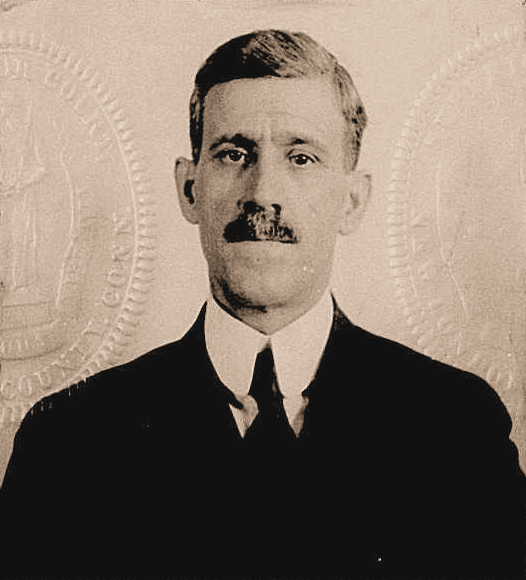 |
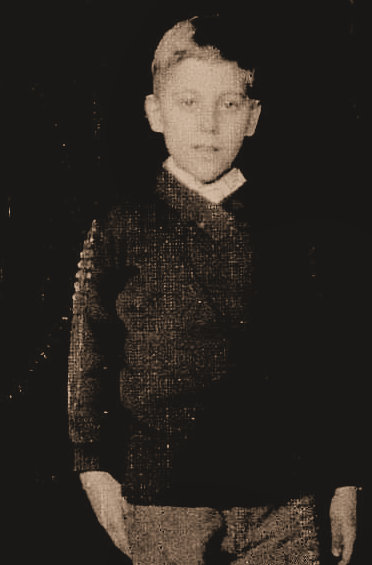 |
||||||||
|
Socrates Patterson from 4 January 1920 Passport Application |
George Patterson from 4 January 1920 Passport Application |
||||||||
|
A 9 January 1920 article in The Norwich Bulletin [52],reported that Socrates and Stavros Peterson sailed from New York on Tuesday, 6 January 1920 aboard the Megalli Ellas. Socrates and Stavros were preceded on the trip by Stavros' business partner, T.S. Svoros of Norwich, who was retiring and planning to remain in Greece. Young George Patterson was not with them. At some point in 1919, George was involved in an accident with a motorcycle and he sustained a bad injury on his leg. In a letter Socrates wrote to George on 11 February, Socrates inquired about George's leg (see below). This no doubt was the reason George didn't accompany Socrates on the trip. The 1920 census was taken on 12 January 1920, showing the family had now moved to 58 Pacific Street, with Socrates, age 48, as head of household; wife Helen, age 33; son Dennis, age 16; Xenophon, age 14; daughter [sic] Constantine, age 13; sons George, age 12; Pandel [sic](Pontelius or Ponte), age 10; Demosthenes, age 9, and daughter Sophia, age 1 year 6 months; along with niece Fatika (Balassi), age 16; and Mary Kaslyini, servant, age 38 [53]. On January 12, 1920, Socrates sent a postcard to his 13-year-old son, Constantine. The postcard had an image of the Acropolis on the front. On the back he wrote: M
|
|||||||||
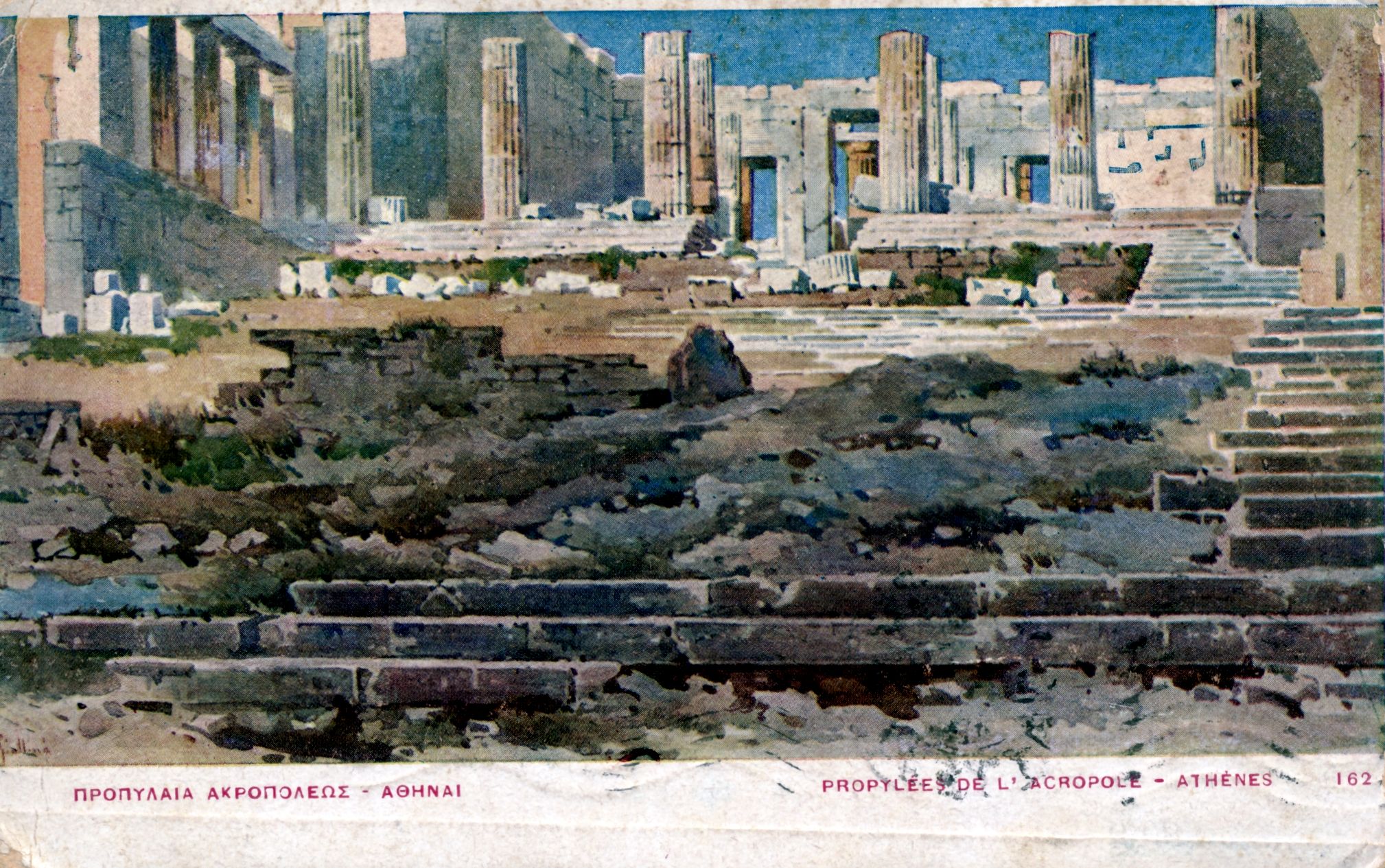 |
|||||||||
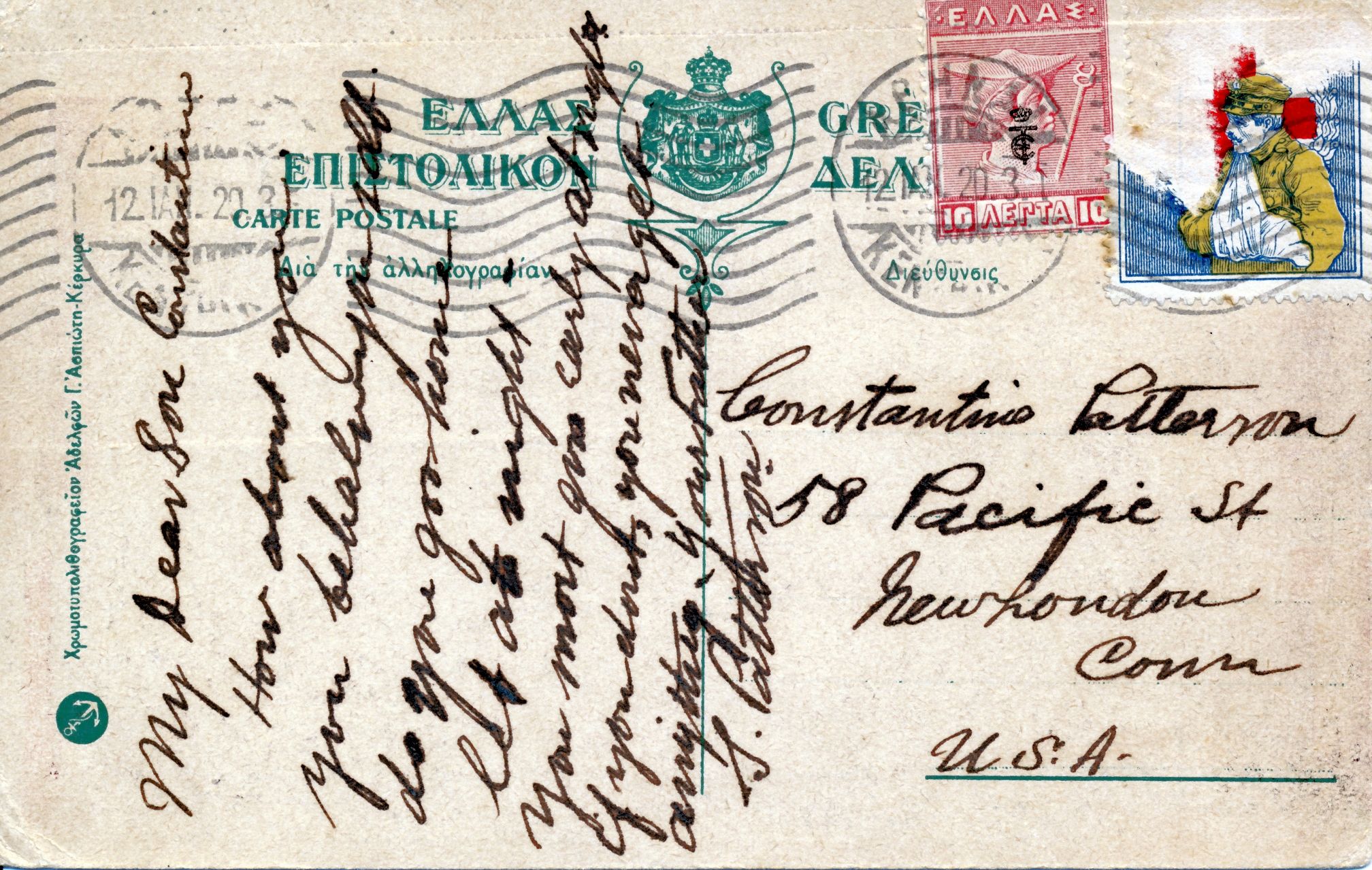 |
|||||||||
|
A month later, Socrates wrote the following letter to his 11-year-old son George, mentioning George's leg injury: Konstantinople My Dear Son
George. |
|||||||||
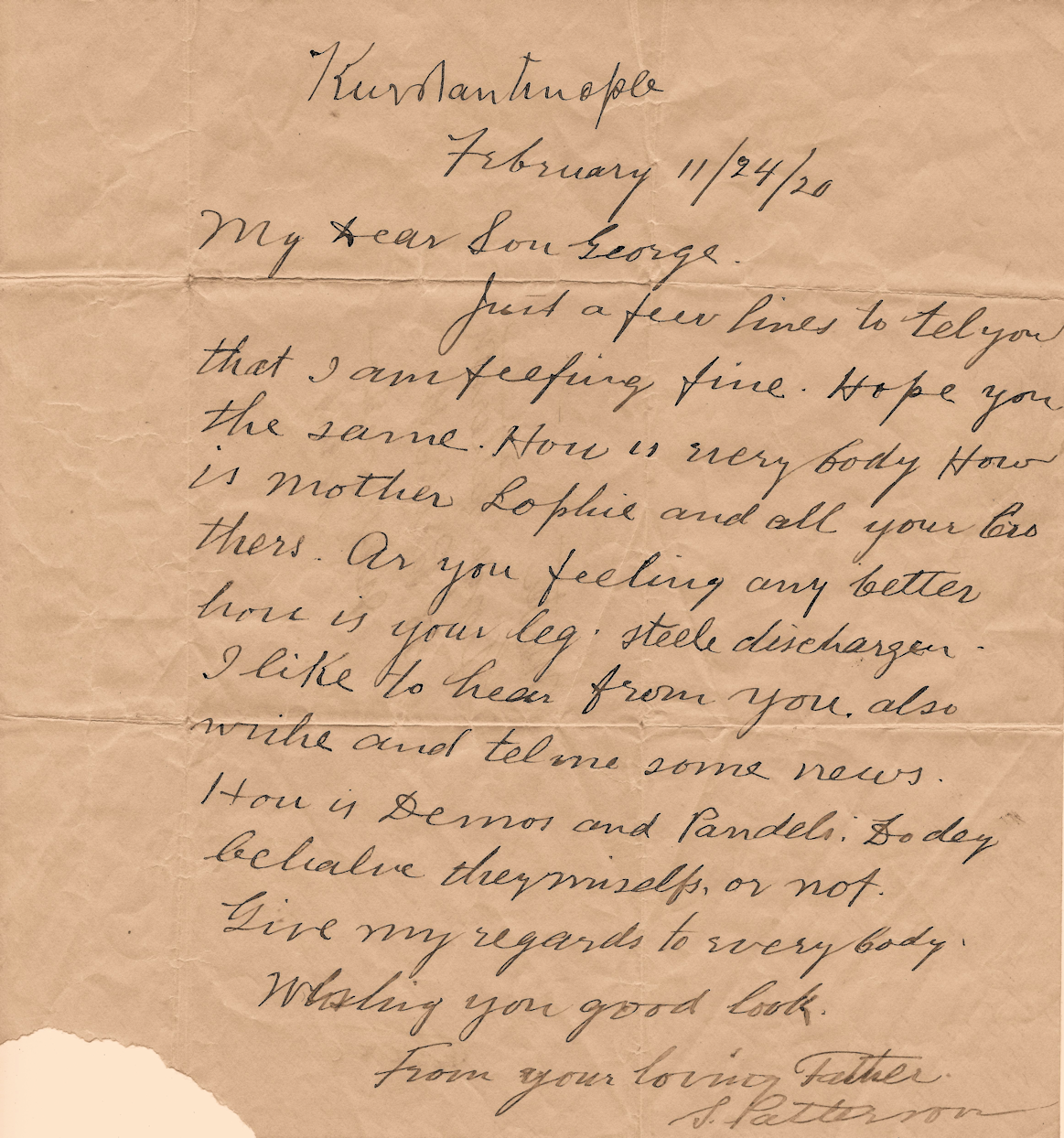 |
|||||||||
|
|
|||||||||
|
The Death of Socrates Patterson |
|||||||||
|
Although the living family knows little else of Socrates' activities abroad in 1920, it is clear that his health rapidly deteriorated. Two and one-half months after Socrates departed New York, on 19 March 1920, the American Consulate issued a Report of the Death of an American Citizen[54], stating that Socrates Patterson, a naturalized citizen, had died 16 March 1920 at the Hospital Franchet d’Esperey in Constantinople of kidney disease. Socrates was buried at the Şişli (Chichli ) Greek Orthodox Cemetery in Constantinople, and his effects were given to his father-in-law, George Kelezides [sic] of Passage Crespin, Pera, Constantinople. The report listed Socrates’ residence as Pacific Street, New London, Connecticut. He was 47 years old. Socrates was survived by Helen, now 34, and seven children between the ages of 16 and one. It is interesting that a note at the bottom of the page states, “Certificate of death issued by the Oecumenical Patriarchate March 3rd, 1920", so perhaps this was the actual date of his death, and the date of burial was March 16. An article in The Day [55] noted that Socrates Patterson had built up a highly profitable business after a long struggle and at the time of his death in 1920, his estate filed in the local court was $100,638 (about $1,446,691 in 2022 value), principally in cash. Socrates' entire estate was bequeathed to Helene. It was considered one of the largest cash estates in New London at the time (Patterson Family Oral History). On April 15, 1920, Socrates' older brother, Leonidas, set sail for America aboard the S.S. Presidente Wilson, departing Trieste, Italy and arriving at New York Harbor on May 3, 1920 [56]. His stated purpose of his visit was to see his nephew, Havro (Stavros) Peterson, however he perhaps also planned to assist with the settlement of his brother's estate. The ship manifest shows that Leonidas was deported, although the reason for deportation is not clear. |
|||||||||
|
|
|||||||||
|
The Death of George Patterson |
|||||||||
|
The family tragedy was compounded after Socrates' death. Young George Patterson, now 12 years old, contracted tuberculosis of the hip. During the nineteenth and early twentieth centuries, tuberculosis was the leading cause of death in the United States [57]. The most common form of non-pulmonary tuberculosis in children was tuberculosis of the bones and joints [58]. Five months after Socrates' death, George became ill with bronco-pulmonary pneumonia, which led to the rapid deterioration of his health. His death certificate stated his primary cause of death was "tuberculosis hip" and the secondary or contributory cause was broncho-pneumonia [59]. George died on 3 August 1920 at Ocean Beach, probably at the Bentley Avenue house. He was buried at Jordan Cemetery in Waterford, Connecticut. In May 1957, George's remains were disinterred and moved to Cedar Grove Cemetery in New London where Helene was buried in November 1956. |
|||||||||
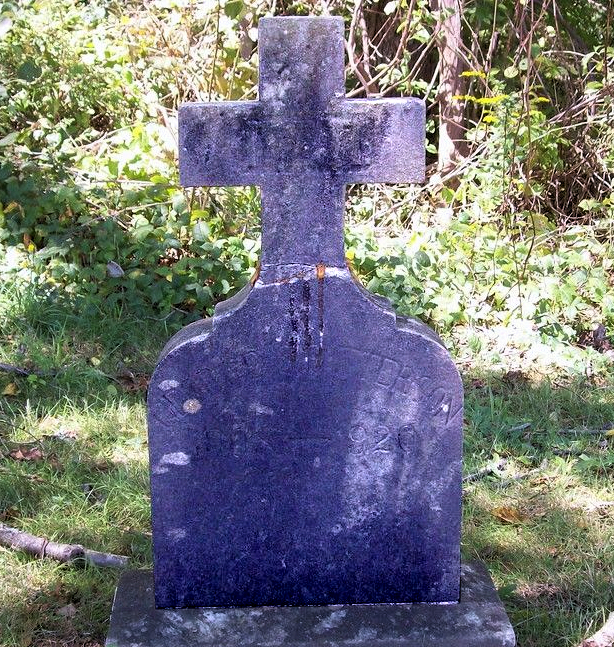 |
|||||||||
|
George Patterson's original headstone from Jordan Cemetery in Waterford, Connecticut Photo: Copyright 2011, Janice Watrous |
|||||||||
|
|
|||||||||
|
Helene's Relationship with Gus Kelles (Constantine Kelessidis) |
|||||||||
|
At some point, most likely before Socrates left for Constantinople, Helene became romantically involved with her cousin Constantine Kelessidis (Gus Kelles). Eleven months after Socrates' departure to Constantinople, and 8 1/2 months after Socrates' death, Helene gave birth to a baby girl named Mary, born 1 December 1920, her daughter with Gus Kelles. The cumulative impact on the Patterson children from Socrates' and George's deaths and Helene's relationship with Gus Kelles must have been profoundly traumatic. The older boys were in their teens. Dennis was 16 years old, Rex (Xenophon) was 15, and Constantine turned 14 in November of 1920. Helene sent Rex and Constantine away to boarding school at the Suffield Academy north of Hartford, Connecticut. Two years later, around 1922 or 23, Constantine ran away from boarding school at the age of 16 and stowed away on a cargo ship that went to the Philippines. From there he travelled to Honolulu and eventually made his way to California where he went to work in Hollywood's film industry as an extra and stunt man in silent films for several years (Patterson Family Oral History). |
|||||||||
|
|
|||||||||
|
Lawsuit by James Peterson |
|||||||||
|
On 1 February 1921, articles in The Evening Day [60] and The Norwich Bulletin [61] reported that James Peterson, the nephew of Socrates Patterson, filed a lawsuit against his uncle's estate in probate court. James claimed that Socrates had promised to give him 25 shares of the stock at a value of $100 per share in S. Patterson, Inc., which was incorporated in late 1919 with James as an original stockholder and secretary of the corporation. James also sought back payment amounting in $2,500 salary that was due him but never paid after Socrates' death. The lawsuit requested that Helene Patterson, as administratrix of the Socrates Patterson's estate, give him the stock shares his uncle had promised and credit the salary owed him. Both before and after Socrates' death until July 4, 1920, James had worked as the manager of the Crystal Candy Kitchen. After Socrates died, James asked Helene to give him the 25 shares of stock promised by Socrates. Helene agreed to give James the stock and the back pay owed him, however after the six months of filing claims against Socrates' estate had elapsed, Helene declined to pay the stocks and back pay. James consulted with local attorneys, Daniel M. Cronin and Thomas S. Shields, who advised him to take up the law suit.[62] James Peterson served as manager of the Crystal Candy Kitchen both before and after Socrates Patterson's death until July 4, 1920, at which point Helene then made Gus Kelles manager of the ice cream and confectionary store. This, and Helene's refusal to give James the stock shares and salary owed him, must have cut deep with James. It was another year and a half before James' lawsuit was settled, the details of which were not disclosed in the press.[63] |
|||||||||
|
|
|||||||||
|
Helene
Returns to Constantinople |
|||||||||
|
On 17 March 1921, Helene applied for a passport to travel to Constantinople and Greece to visit relatives.[64] She set sail by herself on the S.S. Alexander the Great on 10 April 1921 and returned to the U.S. from Constantinople on the S.S. King Alexander on 11 October 1921, arriving on 4 November 1921. [65] At three months of age, the infant Mary was separated from her mother for nearly 7 months. |
|||||||||
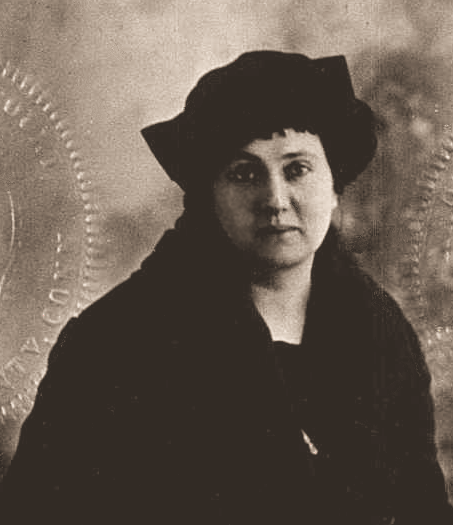 |
|||||||||
|
A passport photo of Helene taken on 26 March 1921 |
|||||||||
|
It's possible that the reason for Helene's return was for her father, George's funeral. George died some time prior to 1926, when Helene's mother, Kaliroi, appeared in the Registre pour l'enregistrement des Grecs non-echangeable without him. Turkish relations with Greeks living in the Ottoman Empire during World War I and its aftermath (1914–1922) became increasingly violent, with the systematic killing of the Christian Ottoman Greek population of Anatolia on the basis of religion and ethnicity. Less than a year after Helene returned to the U.S., the predominantly Greek and Armenian city of Smyrna was burned by the Turkish military, resulting in the death of an estimated 10,000 to 125,000 Greeks and Armenians. The culmination of these events resulted in the 1923 population exchange between Greece and Turkey, an outcome of the "Treaty of Lausanne". The"Convention Concerning the Exchange of Greek and Turkish Populations" was signed at Lausanne, Switzerland, on 30 January 1923, by the governments of Greece and Turkey. The Greeks of Constantinople, which became Istanbul in 1924, were initially excluded from the population exchange of 1923 and were allowed to remain in their native city, however, the Turkish government enacted a series of draconian measures that gave many Greeks no option but to leave Istanbul. The Registre pour l'enregistrement des Grecs non-echangeable was a registry of Greeks who remained in Istanbul after the population exchange. Helene's mother, Kaliroi, was listed living in Büyükdere, a quarter of Istanbul's Sariyer district, at Asmali Sokat 16. Helene's sister, Hariklia, was also listed in the registry, visiting Kaliroi at Asmali Sokat 16, but living in Athens at Kifissia, Nea Erythraia. |
|||||||||
|
|
|||||||||
|
Christmas Morning Fire at 74-76 State Street; Helene marries Gus Kelles |
|||||||||
|
On 25 July 1921, Gus Kelles filed his Declaration of Intention to become a naturalized citizen in New London Superior Court. He listed himself as single, by the name of Constantine Kelessides, living at 76 State Street (the location of the Crystal Candy Kitchen) in New London. By 1922, Gus Kelles appeared in the New London Directory, employed as manager at 76 State Street (the Crystal Candy Kitchen), but living at 36 Tilley Street. Helene was listed in the 1922 directory as "Mrs. Helen Patterson", also living at 36 Tilley Street. In the 1923 New London Directory, Gus Kelles was again listed as employed as manager at 76 State Street, living at 36 Tilley Street, but in this listing, Helene was listed as his wife. They technically weren't married yet because they he didn't apply for a marriage license until 2 March 1924. Ironically, Helene was also listed by herself in the 1923 directory as Mrs. Helen Patterson, living at 36 Tilley Street. In the early morning of 25 December 1923, a fire broke out in Patterson's confectionary, ripping through the building. Although few details are available of the fire, the extent must have been significant because in two news articles, the building appears to have been a complete loss. A 4 January 1924 article in The Day reported that Gus Kelles, general manager for Patterson's confectionary at 74-76 State Street, burned out on Christmas morning, denied there were any definite plans to construct a five-story business building on the site. In a 16 March 1924 article[x] in The Hartford Courant, "Mrs. Helen Patterson Kelles" applied to Building Inspector Benjamin R. Licinus for permission to build a three-story store and office building at numbers 74-76 State Street. The building was of fire proof construction throughout. The estimated cost of the building was $40,000 with George R. Beaudette named as architect and Miller & Symington as contractors. Less than two months after the fire, on 2 March 1924, Helene and Gus applied for a marriage license in New York. The assumption is they were married shortly thereafter in New York. None of the Patterson children were in attendance, however Rex recalled congratulating the couple when they returned. [x] Once the new building with ice cream parlor was rebuilt, Helene renamed it "Patterson's Confectionery and Ice Cream Parlor. The photo below is from a post card showing the new interior of the building. |
|||||||||
|
|
|||||||||
|
Patterson's Confectionery and Ice Cream Parlor, 76 State Street. Photo: From a postcard, courtesy of J. Ruddy |
|||||||||
|
|
|||||||||
|
The Disappearance of Gus Kelles |
|||||||||
|
Helene and Gus were married for less than three and one-half years when disaster struck again. On the evening of 20 August 1927, Gus Kelles left the home he shared with Helene in New London to attend a poker game and party in Saybrook, Connecticut. He was driving a borrowed (some reports say it was Helene's) automobile, known as an open Wills St. Clair Roadster. Gus reportedly left the poker game a winner and departed Saybrook in the early hours of the morning on 21 August 1927. As he drove along the causeway between the mainland and Cornfield Point in the town of Saybrook, the automobile collided with and went through the highway fence on the easterly side of the causeway.[x] Gus' body was never found. It was initially feared he met with foul play, but that idea was later abandoned [x]. Gus' friends declared they had no information from him after he left the party, but they did not believe he was dead. Helene made a general search and inquiries of state and city police, of Gus' friends and relatives, and search has also been made by the various insurance accompanies, which have insurance policies on the life of Kelles. The assumption was that Gus was thrown from the vehicle either onto the rocks abutting the waters of Long Island Sound or into the waters of Long Island Sound and was killed or drowned. [x] Helen had to wait seven years after the accident for Gus to be claimed deceased and for her to pursue collecting on the insurance policies under which he was covered [x]. |
|||||||||
|
|
|||||||||
|
S. Patterson, Inc. Files for Bankruptcy |
|||||||||
|
The S. Patterson, Inc. confectionary business never recovered from the combined effects of the December 1923 fire, and poor overall management of the company after Socrates' death. Almost a year to the date of Gus Kelles' disappearance, on 18 August 1928, Rex (Xenophon) Patterson filed a petition for bankruptcy on behalf of S. Patterson, Inc. confectioners of 76 State Street. The petition listed liabilities of $62,941 of which $61,654,42 were unsecured claims. Assets of the company were set at $5,650 with $5,500 representing machinery and tools. In 8 short years, Socrates Patterson's entire fortune that he worked so hard to build was lost. |
|||||||||
|
|
|||||||||
|
The Birth of Another Daughter |
|||||||||
|
Helene never remarried. She eventually went to work for Stavros Peterson as the hostess of his establishment. At some point in 1928 or earlier, Helene became involved with a New London barber, Paraskeva (Perry or Paries) Paspatis. He was a Greek immigrant from the town of Paleokipas, Mytilene on the island of Lesvos, 12 years younger than Helene. From 1927 to 1929, Perry Paspatis lived and conducted his barber business at 14 Bank Street, a 1-minute walk around the corner from 76 State Street. A baby girl was the result of this relationship. Named Patricia Kelly on her birth certificate, the baby was born 16 March 1929 at Home Memorial Hospital in New London. Helene, age 42, gave her name as Helen Kelly on the birth certificate, and listed the father as Perry Perry, age 35 of New York (he was actually only 30 years old) (Patterson Family Oral History). The baby girl was immediately placed in an orphanage. She was eventually adopted and raised by a couple who, ironically, gave her the name Helen. Years later, Helen tried to connect with Helene and her Patterson siblings, but Helene wanted no contact with her. Fortunately, many years later, Helene's grandchildren and great-grandchildren have had the great pleasure of getting to know Helen's children (also Helene's grandchildren). In the 1930 U.S. Census, Helene appeared with her son, Constantine, age 23, and daughters Sophie, age 12 and Mary, age 9, living in a rented home at 19 Terrace Street in New London. The 1930 census was taken 7 April 1930. A little more than a year later, Constantine would be married with a new baby of his own. |
|||||||||
|
|
|||||||||
|
A Final Trip to Turkey and Greece |
|||||||||
|
In 1934, Helene returned to Turkey and Greece one last time. While in Istanbul, the Turkish government took away her passport because it was claimed she owed back taxes. According to the family, it took six weeks of negotiations for the passport to be returned to her (Patterson Family Oral History). Helene returned to the U.S., leaving Piraeus, Greece on 4 October 1934 and arriving at New York Harbor on 19 October 1934. |
|||||||||
|
In the 1940 U.S. Census, Helene appeared with her daughter Mary, age 19, and her "step child" Tarso Apostolos, age 17, living in a rented home at 50 Federal Street in New London. Tarso was the orphaned daughter of distant relatives of Socrates that Helene took in as a foster child. Helene listed her employment as a cashier in a retail store - this would be Peterson's Candy Kitchen. Mary's employment was listed as a clerk in a retail store - and this would be the Capitol Candy Kitchen owned by her "uncle" Emmanuel Jackson (he was Helene's first cousin), and Emmanuel Jackson's cousin, Christos Manos. The census was taken on 15 April 1940. A year later, Tarso would be married to Helene's son, Ponte (Pandelis).Three years later, against Helene's wishes, Mary would enter the Women's Army Corps with the assistance of her sister-in-law, Bertha (Constantine's wife). According to the family,
Helene's sister, Hariklia, died of starvation and was buried in a
common, mass
grave in Athens (Patterson Family Oral
History). In early World War II, the winter of 1941-1942 was a period of mass
starvation known as the
"The Great Famine".
The Axis powers (Nazi Germany and Fascist Italy)
invaded and occupied Greece and the Allied forces responded with a full
naval blockade in order to weaken the Axis in its military efforts. This cut
off all imports to Greece, including food (Neelson & Stratmann, 2010).
During the first winter of occupation, 1941-1942, the shortage of food was
acute and famine occured in Greece's urban areas, especially Athens.
Mortality reached a peak during the winter of 1941-1942, with an estimated
300,000 Greeks dying from starvation In the 1950 U.S. Census, Helene, age 64, was living with her daughter Sophie, Sophie's husband Pericles Haleftiras and their three daughters at 46 Summit Avenue in New London. Helene's mother, Kaliroi, remained in Büyükdere and lived to be 94 years of age. Her death would have taken place between 1954-1956. In 6-7 September 1955, the Greek population of Istanbul and its surrounding neighborhoods were the victims of the Istanbul Pogrom, a heinous event that resulted in the suffering, injury and death of many Turkish Greeks, and the destruction of their homes and businesses. It's not known if Kaliroi lived through this event or if she was a victim of it, but most of Büyükdere’s Greeks left for Athens and Thessaloniki after September 1955 [x]. By 1956, Helene had moved with
Sophie's family to a new home at 56 Millstone Road in Waterford,
Connecticut. On 20 November 1956, Helene suffered a coronary occlusion. She
died 8 days later, on 28 November 1956. She was 70 years old. She was
buried at Cedar Grove Cemetery in New London. In May 1957, her son George's
remains at Jordan Cemetery were disinterred and moved to Helene's burial plot at Cedar Grove
Cemetery. |
|||||||||
|
|
|||||||||
|
Works Cited |
|||||||||
|
6th Joint Exchange Subcommittee. (1927-1933). Registre pour l'Enregistrement des Grecs Non-Echangeable. Retrieved from Anthemion - The Digital Library of the Greeks of Constantinople: http://anthemion.phs.uoa.gr/index.php/el/ Byington, Q., McClelland, W., & Quint, Z. (2022). All the Sultan's Men: The Ottoman Empire and its Greeks. In "That Greece Might Still Be Free": Commemorating the Bicentennial of the Greek War of Independence from an International Perspective. Regents of the University of Michigan. Retrieved from https://apps.lib.umich.edu/online-exhibits/exhibits/show/200th-anniversary-greek-war/all-the-sultans Deringil, S. (1993). The Invention of Tradition as Public Image in the Late Ottoman Empire, 1808 to 1908. Comparative Studies in Society and History, pp. 3-29. Jackson, E., Manolakis, C., Nichols, E., & Patterson, H. (1922, August 1). Sale of 83 Broad St., New London, Connecticut. New London: In possession of John Ruddy, grandson of Christ Manalakis. Neelson, S., & Stratmann, T. (2010, April 12). Effect of Prenatal and Early Life Malnutrition: Evidence from the Greek Famine. CESIFO WORKING PAPER NO. 2994 , p. 35. Türkan , A. (2015, May). Turkey-Vatican Relations from the Ottomans to the Republic. International Journal of Humanities and Social Science, 5, pp. 148-163. Voglis, P. (2006). Surviving Hunger: Life in the Cities and the Countryside during the Occupation. In R. Gildea, O. Wieviorka, & A. Warring (Eds.), Surviving Hitler and Mussolini: Daily Life in Occupied Europe (pp. 16-41). Berg: Oxford. |
|||||||||
 |
|||||||||
|
|||||||||
 |
|||||||||
|
The leaf graphic on this page is from a scan
of a stencil, Olive Branch, I purchased from the Dressler Stencil Company. |
|||||||||
|
The background paper for this page is from Last updated: Sunday, August 07, 2022 02:07:14 PM |
|||||||||
